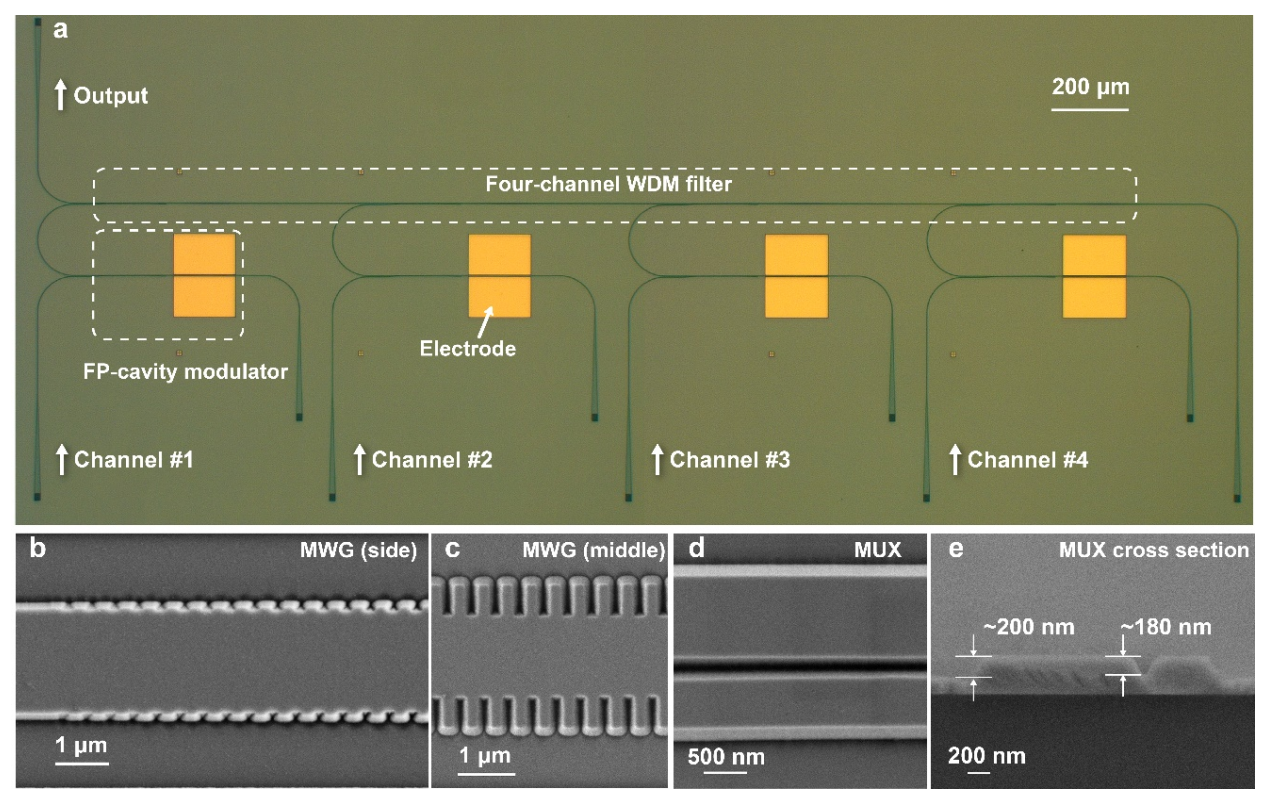
Fayetteville, Georgia Oct 15, 2023 (Issuewire.com) – Main text
High-performance thin-film lithium niobate optical modulators have emerged that are highly expected to satisfy the ever-growing demand for high-capacity optical interconnects utilizing multiple channels in parallel. A compact lithium-niobate-on-insulator (LNOI) photonic chip was adopted to establish four-channel wavelength-division-multiplexing (WDM) transmitters comprising four optical modulators based on ultra-compact 2 — 2 Fabry-Perot cavities and a four-channel WDM filter based on multimode waveguide gratings.
With the growth in artificial intelligence (AI), 5G systems, cloud computation, and the Internet of Things, transmitters with extremely high capacities are required for data communication. Ultrafast optical modulation is an essential technology for high-capacity transmitters. High-speed optical modulators have attracted considerable interest. Significant progress has been achieved using different mechanisms in various material systems.
In a new paper published in Light: Advanced Manufacturing, a team of scientists led by Daoxin Dai from Zhejiang University developed a compact lithium-niobate-on-insulator (LNOI) photonic chip.
Optical modulators on a lithium-niobate-on-insulator (LNOI) platform have exhibited great potential. This arises from a linear electro-optic (EO) effect, low excess loss, and high stability. LNOI EO modulators based on Mach-Zehnder interferometers and microresonators have performed excellently. The length of the phase-shifting arms is typically several millimetres, or even centimetres, to realize a low voltage. Travelling-wave electrodes have been introduced, along with high-speed MZMs. Due to their large footprint, the arraying LNOI MZMs is inconvenient for high-capacity multiplexed systems with multiple channels.
Alternatively, the resonator-based modulators of LNOI can be compact, which may reduce power consumption. Therefore, resonator-based LNOI modulators have attracted significant attention in recent years. The research team has successfully demonstrated high-speed LNOI modulators based on a specific 2 — 2 Fabry-Perot (FP) cavity. It enables an ultra-high 3-dB bandwidth beyond 110 GHz and data capacity up to 140 Gbps. The footprint of the modulation section is much smaller than that of the reported LNOI ring resonator modulators. It is very attractive for arraying wavelength-division multiplexing (WDM) systems.
Meanwhile, advanced multiplexing techniques have been widely studied to expand link capacity by transmitting data through multiple channels in parallel. WDM has been successfully applied in which multiple wavelength channels are introduced. In recent years, various waveguide structures have been developed to realize WDM filters with excellent performance.
Great efforts have been made, and impressive progress has been achieved utilizing smart designs without waveguide bends in key regions. A four-channel coarse WDM transmitter chip on LNOI has been demonstrated using a multiplexer, including an angled multimode interferometer. The research team proposed and developed a promising LNOI photonic filter based on a straight multimode waveguide grating (MWG). It enables a box-like spectral response whose central wavelength and bandwidth can be designed flexibly. A four-channel WDM filter with box-like responses was established using cascaded LNOI MWGs for the first time.
Photonic waveguides and circuits of large scale present increased manufacturing requirements. High-quality fabrication is critical for achieving low-loss and low-phase error light propagation in optical waveguides. Several typical fabrication technologies have been established for LNOI photonic waveguides. Dry-etching is preferred because of its process compatibility and fabrication repeatability. Inductively coupled plasma (ICP) etching with Ar gas is one of the most common methods for fabricating LNOI photonic waveguides and devices.
The chip features transport cascading and channel uniformity. Experimentally, the proposed chip enables high-capacity data transmission of 320 Gbps OOK signals, and 400 Gbps PAM4 signals with a low power consumption of 11.9 fJ/bit. This indicates enormous potential for the large-scale photonic integration of LN and the bright prospect of LNOI regarding its widespread use in integrated photonic devices.
The present photonic chip with an ultracompact footprint can be scaled for more channels and thus shows great potential for further realization of ultrahigh-capacity and energy-efficient WDM transmitters on LNOI in the future. Introducing SiO2, amorphous-Si, or Cr hard masks can improve the fabrication process. With an improved etching process, the propagation loss (mainly originating from the scattering loss at the sidewalls) can be reduced to a wafer scale. It will support the development of high-performance LNOI photonic integrated circuits and satisfy the growing demands for various applications.
Additional information
DOI
10.37188/lam.2023.013
Origrinal URL
https://www.light-am.com/article/doi/10.37188/lam.2023.013
Funding
This work was supported by the National Major Research and Development Program, National Science Fund for Distinguished Young Scholars, National Natural Science Foundation of China (NSFC), Zhejiang Provincial Natural Science Foundation, Zhejiang Provincial Major Research and Development Program, Leading Innovative and Entrepreneur Team Introduction Program of Zhejiang, and the Fundamental Research Funds for the Central Universities.
About Light: Advanced Manufacturing
Light: Advanced Manufacturing (LAM) is a new, highly selective, open-access, and free-of-charge international sister journal of the Nature Journal Light: Science & Applications. The journal aims to publish innovative research in all modern areas of preferred light-based manufacturing, including fundamental and applied research and industrial innovations.
About TranSpread
TranSpread is an expert team made up of international tech media professionals and seasoned international academic publishers. Equipped with extensive international media publishing resources and experience in operating new media for scientific and technological journals, our primary objective is to offer a full suite of overseas promotion services for journals. We strive to enhance the overall overseas promotion of articles, broaden journal exposure, escalate global attention, and swiftly amplify the international impact of these journals. Our professional TranSpread team is dedicated to providing superior-quality overseas promotion services for journals, thereby empowering them to wield greater influence in the international academic landscape.
Please visit www.maxapress.com/TranSpread for more information.
Media Contact
Daoxin Dai
8654055638
1833 Highway 85 S Fayetteville, GA 30215-2903
Source :TranSpread
This article was originally published by IssueWire. Read the original article here.
COMTEX_441953740/2777/2023-10-16T02:07:23
Julian Lopez is professor emeritus of finance, served as the founding academic affairs dean and founding chair of the finance department.
Disclaimer: The views, suggestions, and opinions expressed here are the sole responsibility of the experts. No journalist was involved in the writing and production of this article.
